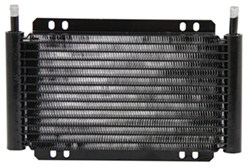
How To Install Aftermarket Transmission Cooler On Vehicle with ATF Warmer
Question:
I need help identifying the ATF return line on my 2015 Honda Accord 3.5L V6 where I will install the Derale Series 8000 transmission cooler. This model of car does not route the ATF lines to the radiator... they go to the ATF Warmer mounted above the transmission. I understand that the ATF Warmer is a heat exchanger between the radiator coolant and the ATF, and actually serves to both warm and alternately cool the ATF as need dictates. In the Honda Service Information System SIS, they use the terms ATF inlet line and ATF outlet line. Logically I assume the ATF inlet line indicated in red in the photo, and including the ATF filter is their term for ATF return line. However, as you can see in the photo, while performing the line temperature test, the ATF inlet line was running approximately 30 degrees warmer than the ATF outlet line. What Im going to ask next will require an open mind... is it possible that the ATF Warmer is reversing the results of the line temperature test? I ran the car on blocks, in Drive, at various speeds 100-3,000 rpm for 15 minutes dashboard temperature gauge indicated normal operating temperature. Could the ATF Warmer have been actually warming the ATF going into the transmission, making it hotter than the ATF leaving the transmission? Would the temperature results be reversed to what I would have expected when the transmission is under a heavy load instead of simply spinning the wheels in the air? So my question... which line should I the transmission cooler into, ATF outlet line or ATF inlet line?
asked by: Scott
Helpful Expert Reply:
The ATF warmer will both bring transmission fluid up to temperature faster during startup and colder weather as well as reduce temperature when heat build-up occurs. This can sometimes contradict typical line testing results you'd be accustom to but a cooler such as the Derale Series 8000 Plate-Fin Transmission Cooler Kit part # D13502 will still need to be installed on the return line. It is best to use factory diagrams to identify the return line as opposed to testing by feel as you would normally.
We do not have factory diagrams to reference unfortunately.

Product Page this Question was Asked From
Derale Series 8000 Plate-Fin Transmission Cooler Kit w/Barb Inlets - Class III - Efficient
- Transmission Coolers
- Plate-Fin Cooler
- Mid-Size Truck
- SUV
- Van
- Standard Mount
- 11W x 7-1/4T x 7/8D Inch
- With 11/32 Inch Hose Barb Inlets
- Derale
more information >

Continue Researching
- Article: Frequently Asked Questions About Transmission Coolers
- Article: Brake Controller 7- and 4-Way Installation Kit (ETBC7)
- Q&A: 2022 GMC Acadia Transmission Cooler Recommendation for Trailer Towing
- Q&A: What is the Difference Between a 4-Way and 7-Way Trailer Connector
- Q&A: Is There a Lock For Flint Hill Goods Cargo Carrier & Ramp FHG69ZR
- Article: Transmission Cooler
- Q&A: Recommended Hitch, Wiring Harness, and Mounting Brackets for a 2017 Honda Odyssey
- Q&A: Can V92 Tow Package be Added to 2012 Chevy Traverse LT
- Article: Brake Controller Installation: Starting from Scratch
- Article: Choosing the Right Suspension Kit for Your Truck and Trailer
- Article: Anti-Rattle Devices
- Article: Engine Oil Coolers
- Q&A: Choosing a Transmission Cooler for a 2019 Jeep Grand Cherokee
- Q&A: Correct Transmission Line Fittings to Install Transmission Cooler on 2009 Chevy Traverse





